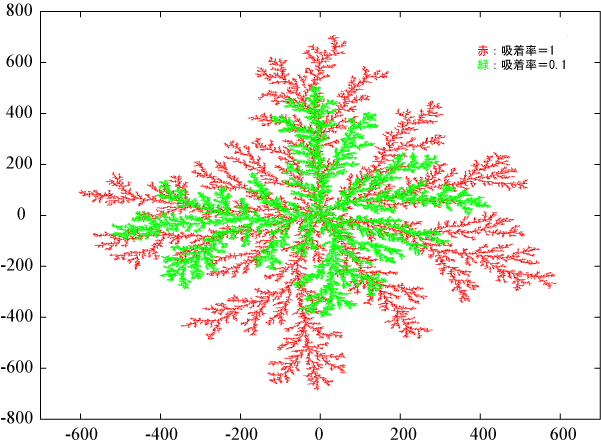DLAシミュレーション2
DLAシミュレーション2
ブラウン運動している粒子(ブラウン粒子)が、結晶化している粒子の隣に来たときに結晶化する率(吸着率)を変化させて、
結晶成長の吸着率依存性についてシミュレーションしてみる。
(※DLAについてはこちら)
計算結果
粒子数=100,000
吸着率=1, 0.1
以上の計算結果を以下に掲載する

吸着率が0.1のほうが、ブラウン粒子は中心部までたどりつきやすいので、全体的に太ったようになる。
VisualC++ + DirectX のソース
注意:以下のソースには、無駄なインクルードがあります。
#include <math.h>
#include <stdlib.h>
#include <time.h>
#include <fstream>
#include <sstream>
#include <iostream>
#include <string>
#include "mt19937ar.h" //メルセンヌ・ツイスタ
#include <cstdio>
#include <iomanip>
#include <stdio.h>
#include <direct.h>
using namespace std;
double PI = 3.14159265358979323846;
double e = 2.7182818284590452354;
//備考:画面サイズはデフォルトで、640×480
int dimension = 2;
int core_number = 0; // 固まった数
int N_max = 100000;
bool core[20001][20001] = {false}; //中心座標(0.0)=配列中心[10000][10000]
int x_0 = 10000;
int y_0 = 10000;
double R = 200.0;
double r = 1.0;
//核の座標
class Perticle{
public:
int D[10];//10次元までの座標
Perticle(){
for(int j=0; j<dimension; j++ ){
D[j] = 0;
}
double theta=2.0*PI*genrand_real1();
D[0]= int(R*cos(theta));
D[1]= int(R*sin(theta));
}
void Step(){
int nn = int(dimension * genrand_real1());
double pp= genrand_real1();
if(pp>0.50) D[nn]++;
else D[nn]--;
if(core[x_0+D[0]][y_0+D[1]]==true){//排除体積効果
if(pp>0.50) D[nn]--;
else D[nn]++;
}
if(D[0]<0 - int(R)) D[0] += 2*int(R);
if(D[0]>0 + int(R)) D[0] -= 2*int(R);
if(D[1]<0 - int(R)) D[1] += 2*int(R);
if(D[1]>0 + int(R)) D[1] -= 2*int(R);
}
void Restart(){
double theta=2.0*PI*genrand_real1();
D[0]= int(R*cos(theta));
D[1]= int(R*sin(theta));
}
};
int main(){
init_genrand((unsigned)time(NULL));
string current_s,folder_s;
current_s = "D:/DLA/result/D2/";//計算結果フォルダの場所
_mkdir(current_s.c_str());
for(int n=1; n>0;n--){
core_number = 0;
r=1.0;
R=200;
// コアの初期化
for(int i =0; i<=20000;i++){
for(int j=0; j<=20000;j++){
core[i][j] = false;
}
}
double probability = 0.1* double(n);//接触時の吸着確率
ostringstream foldername;
foldername << "DLA-" << n << ".data";
folder_s = foldername.str();
folder_s = current_s + folder_s;
ofstream fout_position;
fout_position.open(folder_s.c_str());
Perticle p[1];
core[10000][10000]= true;
cout << core_number <<" "<< 0 << " " << 0 <<" r=" << r << endl;
fout_position << 0 << " " << 0 << endl;
while(core_number<=N_max){
for(int i=0; i<1; i++){
p[i].Step();
if(core[x_0+p[i].D[0]+1][y_0+p[i].D[1]] == true || core[x_0+p[i].D[0]-1][y_0+p[i].D[1]] == true || core[x_0+p[i].D[0]][y_0+p[i].D[1]+1] == true || core[x_0+p[i].D[0]][y_0+p[i].D[1]-1] == true ){
if(probability>genrand_real1()){
core_number++;
core[x_0+p[i].D[0]][y_0+p[i].D[1]] = true;
if(pow(double(p[i].D[0]),2)+pow(double(p[i].D[1]),2) > pow(r,2)){
r = sqrt(pow(double(p[i].D[0]),2)+pow(double(p[i].D[1]),2));
R = (r+200.0)*2.0;
}
fout_position << p[i].D[0] << " " << p[i].D[1] << endl;
cout << "n=" << n << " " << core_number << " " << p[i].D[0] << " " << p[i].D[1] << " r=" << r << endl;
p[i].Restart();
}
}
}
}
fout_position.close();
}
}
今後の予定
・吸着率に対するフラクタル次元を計算する































